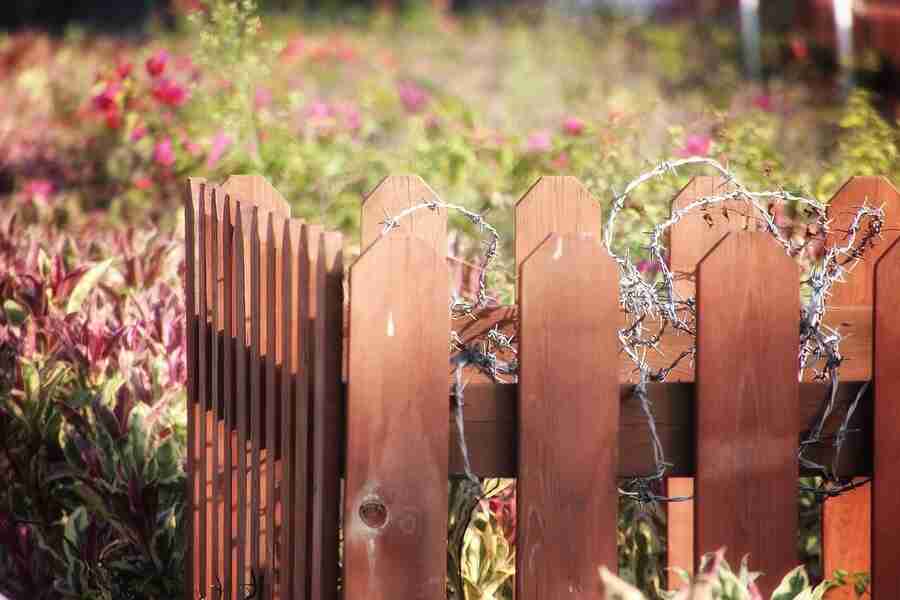
Welcome to our comprehensive guide on selecting the perfect fence for your garden! Whether you’re a seasoned gardener or just starting out, choosing the right fence is a crucial decision that can significantly impact the overall aesthetics, functionality, and atmosphere of your outdoor space.
Gardens are not only places of beauty and tranquility but also sanctuaries that deserve protection and definition. A well-chosen fence not only enhances the visual appeal of your garden but also serves practical purposes such as providing privacy, security, and defining boundaries.
In this guide, we will walk you through the intricate process of selecting the ideal fence for your garden, taking into account various factors such as your specific needs, design preferences, environmental considerations, and budget constraints.
From classic wooden fences to modern vinyl and metal options, we’ll explore the pros and cons of each material, helping you make an informed decision that aligns perfectly with your garden’s style and requirements. We’ll also delve into essential aspects such as climate considerations, maintenance requirements, legal regulations, and installation processes to ensure a seamless and hassle-free experience.
Whether you’re aiming for a cozy cottage garden, a sleek contemporary oasis, or a charming rustic retreat, this guide will equip you with the knowledge and insights needed to transform your garden into a true masterpiece. So, let’s embark on this journey together and find the perfect fence to complement and enhance your outdoor paradise!
Assessing Your Needs
Assessing your needs is a crucial step in the process of choosing the right fence for your garden. It involves a thoughtful examination of various factors that will ultimately dictate the type of fence that best suits your requirements.
First and foremost, defining the purpose of your fence is essential. Are you installing it for privacy, security, or purely decorative reasons? Understanding this primary objective will guide the decision-making process throughout.
Privacy requirements vary from one homeowner to another. Some may desire complete seclusion from neighboring properties, while others may only need partial privacy. Considering your specific privacy needs will help determine the height and material of the fence.
Security needs also play a significant role in the assessment. If you have pets or small children, a fence that provides containment and safety is paramount. Likewise, if you live in an area prone to wildlife or intruders, a sturdy and secure fence may be necessary for peace of mind.
Aesthetics and design preferences shouldn’t be overlooked either. Your garden fence is a prominent feature of your outdoor space, so it should complement the overall style and theme. Whether you prefer a traditional wooden fence, a sleek metal design, or something more contemporary, your personal taste should inform your decision.
By thoroughly assessing your needs in terms of privacy, security, and design preferences, you can narrow down your options and choose a fence that not only meets your practical requirements but also enhances the beauty and functionality of your garden.
Understanding Material Options
Understanding material options is crucial when choosing the right fence for your garden. Each material offers its own unique combination of characteristics, including durability, aesthetics, maintenance requirements, and cost. Here’s a closer look at some common materials:
Wood: Wood fences are timeless and versatile, offering a natural look that complements various garden styles. Cedar and redwood are popular choices due to their natural resistance to decay and insects. Pressure-treated pine is another economical option that can withstand the elements with proper maintenance.
Vinyl: Vinyl fences have become increasingly popular due to their low maintenance requirements and durability. They are resistant to rot, decay, and insects, making them an excellent choice for garden fencing. Additionally, vinyl fences come in a variety of styles and colors, allowing homeowners to find the perfect match for their garden aesthetic.
Metal: Metal fences, such as wrought iron, aluminum, and steel, offer durability and security. Wrought iron fences are known for their ornate designs and classic appeal, while aluminum and steel fences provide strength and longevity with minimal maintenance.
Composite: Composite fences are made from a combination of wood fibers and recycled plastic, offering the look of wood with the durability of plastic. They are resistant to rot, decay, and insects, making them an ideal choice for garden fencing in areas with high humidity or moisture.
When selecting a material for your garden fence, consider factors such as climate, maintenance requirements, budget, and desired aesthetic. By understanding the characteristics of each material option, you can make an informed decision that will enhance the beauty and functionality of your garden space.
Climate And Maintenance Considerations
Climate and maintenance considerations are crucial factors to keep in mind when choosing the right fence for your garden. Here’s a breakdown of what to consider:
- Weather Resistance:
- Evaluate the climate of your area, including temperature fluctuations, humidity levels, and precipitation.
- Choose a fence material that can withstand the local weather conditions. For example, in areas with high humidity, materials like vinyl or composite may be preferable due to their resistance to rot and mold.
- Consider the impact of extreme weather events such as storms, heavy winds, or snow on your fence’s durability and stability.
- Durability:
- Select a material known for its durability and longevity to ensure your fence lasts for years to come.
- Factors such as resistance to rot, decay, insects, and UV rays contribute to the overall durability of the fence.
- Some materials, like metal and vinyl, require minimal maintenance to maintain their durability over time.
- Maintenance Requirements:
- Determine how much time and effort you’re willing to invest in maintaining your garden fence.
- Wood fences typically require regular maintenance such as staining, sealing, and occasional repairs to prevent rot and decay.
- Vinyl and metal fences are low-maintenance options that only require occasional cleaning with soap and water to maintain their appearance.
- Composite fences offer the look of wood with minimal maintenance requirements, making them a convenient choice for homeowners seeking durability without the hassle of regular upkeep.
By considering climate and maintenance factors, you can choose a fence material that not only enhances the beauty of your garden but also withstands the elements and requires minimal maintenance over time.

Legal And Neighborhood Regulations
Legal and neighborhood regulations play a vital role in the process of selecting and installing a fence for your garden. Here’s what you need to consider:
- Local Ordinances: Many cities and municipalities have specific regulations regarding the height, location, and appearance of fences. These regulations are typically outlined in zoning ordinances or building codes. Check with your local planning or building department to understand the rules and requirements that apply to your property.
- Homeowners’ Association (HOA) Rules: If you belong to a homeowners’ association, there may be additional rules and guidelines governing the installation of fences. HOAs often have strict regulations concerning fence materials, heights, colors, and styles to maintain a cohesive look within the community. Review your HOA’s governing documents and consult with the association board or management company for guidance.
- Property Line and Boundary Issues: Before installing a fence, it’s essential to accurately determine your property lines to avoid encroaching on neighboring properties. Consult your property survey or hire a professional surveyor if needed. Additionally, discuss your plans with adjacent neighbors to ensure mutual understanding and agreement.
- Permit Requirements: In some areas, you may need to obtain a permit before installing a fence. Permit requirements vary depending on factors such as fence height, location, and material. Check with your local building department to determine if a permit is necessary and to understand the application process.
- Easements and Utility Lines: Be mindful of any easements or utility lines on your property that may impact fence installation. It’s essential to avoid obstructing access to utility easements or causing damage to underground utilities during the installation process.
- Architectural Review Boards: In neighborhoods with architectural review boards or historic preservation districts, you may need to seek approval for your fence design to ensure it meets aesthetic standards and complements the surrounding architecture. Submit your proposed fence plans to the appropriate governing body for review and approval.
By understanding and adhering to legal and neighborhood regulations, you can ensure that your garden fence installation proceeds smoothly and complies with all applicable rules and requirements. Failure to comply with regulations could result in fines, forced removal of the fence, or other legal consequences, so it’s essential to do your due diligence before proceeding with the project.
Installation Process
- Preparation:
- Measure the perimeter of your garden to determine the amount of fencing material needed.
- Clear the area where the fence will be installed, removing any obstacles such as rocks, debris, or plants.
- Check with local utility companies to ensure there are no underground pipes or cables in the installation area.
- Gather Materials and Tools:
- Purchase the necessary fencing materials, including panels, posts, hardware, and any additional accessories.
- Gather tools such as a post hole digger, level, tape measure, saw, drill, hammer, and safety gear.
- Marking and Layout:
- Use stakes and string to mark the layout of the fence, ensuring straight lines and proper alignment.
- Mark the locations for fence posts, spacing them according to the manufacturer’s recommendations.
- Digging Holes for Posts:
- Use a post hole digger or auger to dig holes for the fence posts, making sure they are deep enough to provide stability.
- Insert the fence posts into the holes, ensuring they are plumb and level. Add gravel or concrete to the bottom of the holes for additional support if necessary.
- Installing Panels or Rails:
- Attach fence panels or rails to the posts according to the manufacturer’s instructions.
- Use screws or nails to secure the panels in place, ensuring they are evenly spaced and level.
- Finishing Touches:
- Add any finishing touches such as post caps, decorative elements, or paint/stain as desired.
- Check the entire fence for stability and make any necessary adjustments.
- Cleanup:
- Remove any excess dirt, debris, or construction materials from the installation area.
- Dispose of waste responsibly or recycle materials when possible.
- Maintenance:
- Regularly inspect and maintain your garden fence to ensure its longevity and functionality. This may include cleaning, repainting/staining, and replacing any damaged components.
In conclusion, selecting the right fence for your garden is a decision that requires careful consideration of various factors including your needs, preferences, budget, and local regulations. By assessing these factors and understanding the material options available, you can choose a fence that not only enhances the beauty of your garden but also provides practical benefits such as privacy, security, and durability. Whether you opt for the timeless charm of wood, the low maintenance appeal of vinyl, the strength of metal, or the innovative design of composite materials, investing time and effort into the selection and installation process will undoubtedly yield a rewarding outcome for years to come. So, take your time, explore your options, and enjoy the process of creating the perfect garden fence for your outdoor sanctuary.


